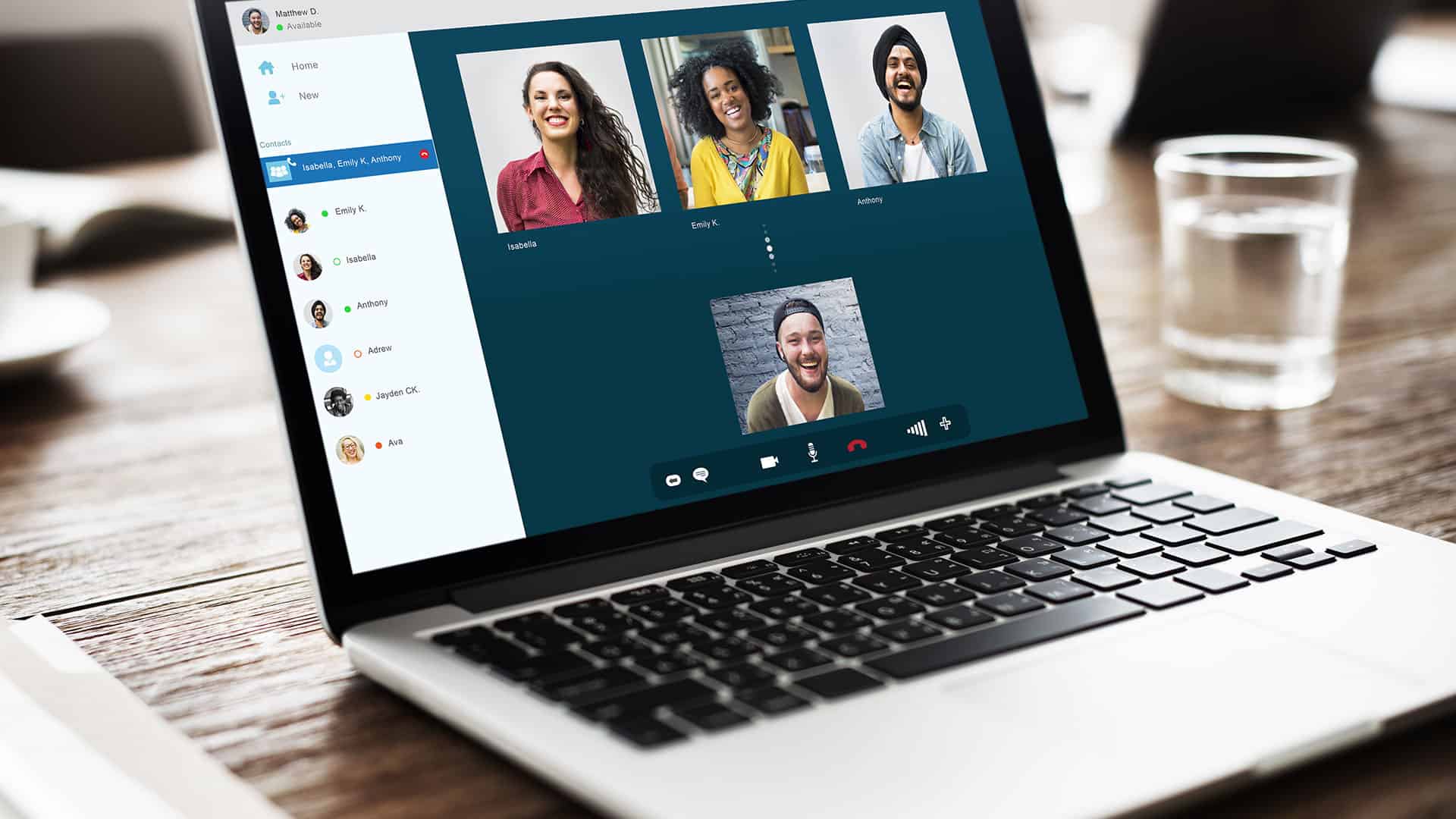How to make sure your video conferencing set-up is accessible and suitable for all-round better collaboration with neurotypical and neurodiverse collaborators alike.
The rapid increase in the use of web and PC client-based video conferencing (VC) and Unified Communications (UC) solutions during the COVID lockdown has been well reported. The pandemic has forced many businesses to switch from face-to-face meetings in the office to remote meetings using technology such as Microsoft Teams.
Before we get on to the eight tips designed to help you make video conferencing as inclusive as possible in your organisation, I’d like to delve a little deeper into the science to highlight why special considerations are necessary.
Processing difficulties
One of the more interesting insights to have come out of this change in working behaviour is the reports of how exhausting many people find their day spent talking over video. There are a number of reasons for this; but it may also be highlighting deficiencies in our cognitive processing or exposing neurodiverse conditions, such as ADHD or autism.
A face-to-face meeting allows a rich social cognition experience with a large number of non-verbal cues being processed. With online meetings, these cues can be difficult to process or lost altogether, depending on the quality of the video link.
Body language can be harder to interpret too, and poor audio quality may affect our ability to interpret the tone of voice being used. Trying to pick up on this social stimulus means our brains are working far harder, consuming more energy and tiring us out.
Importance of a Good VC Experience
For certain people who find face-to-face conversation a difficult experience, VC can offer a less intense alternative, but these people still need good visual and aural stimulus to process the conversation.
That’s because neurodiverse people have to work extra hard to process the relevance of different components of communication; from someone’s facial expressions to their tone of voice. When these cues are absent, it can compound their difficulties.
The Accessibility User Research Collective is a community of people with all types of disabilities who work with Microsoft Research on helping make technology more accessible and usable.
A study paper from last year, discussing how autistic adults coped with video conferencing, found that the use of video was very beneficial “for a neurodiverse population who experience difficulties with non-verbal cues and with expressing and interpreting emotions”. One interviewee reported that “just seeing their conversation partner’s face… ‘gave me something to focus on, even though it is awkward’”.
Visual and audible distractions affect us all, but the heightened sensory sensitivities that autistic people experience can tangibly affect concentration. According to Microsoft research, these distractions “often caused them to inadvertently switch their focus to the noise and lose track of the conversation”.
Interestingly, they concluded that sensitivities of autistic adults are, to varying degrees, present in all of us; so “improving the VC experience for autistic adults can make the VC experience more comfortable for all users.” This valuable research is now finding its way into new features in Teams. The new “Together Mode” rolling out in August is designed to combat meeting fatigue by leveraging segmentation technology to set all the call participants on a shared background. The idea here is to help people focus on the nonverbal cues of the others on the call. “Dynamic View” gives call moderators more control over how shared content is displayed during a meeting.
Never forgetting that we’re all different and we all have different needs, our eight tips below will certainly help you address some of these issues for the people in your organisation who struggle most with video conferencing:
Tip 1: Find a quiet, comfortable meeting place
During lockdown, finding a good space in the home for video conferencing may prove challenging, especially if the whole family needs to join their own online meetings or lessons at the same time. But, if you can, try to find a comfortable spot that provides as much quiet and privacy as possible.
Tip 2: Respect ‘presence’ when requesting an unscheduled meeting
Always try to respect presence if you want to have an unscheduled meeting with someone. Most UC solutions should offer presence capability, so you can avoid disturbing people who are ‘Busy’.
To protect yourself when you’re up to your eyeballs with work, remember to set your own presence based on whether you are happy to join meetings at short notice or not.
Best practice UC etiquette is to firstly message asking: “are you free for a chat about <subject>?” before calling. This avoids people being forced into a video call when they may not be ready for one. It also gives people who hate unexpected calls the chance to prepare for the conversation.
Tip 3: Use the right technology
Make sure you are using technology which has the correct specification to support the UC client. Poorly performing hardware will only raise stress and anxiety levels. Imagine having a meeting room with broken chairs, a wonky desk, and a broken projector – it’s pretty much the same thing!
Using a good quality headset will also help, reducing background noise distractions. Watch this space as third party companies like Krisp are currently developing innovate apps to cancel out background noise altogether.
The background blur or image is another great feature, removing background visual distractions. Please note, this feature also needs a suitable spec PC to work.
Tip 4: Try to avoid using mobile
The stability and reliability of a good quality desktop and webcam will usually work best for your video meeting. Microsoft found that interviewees in their study, discussed earlier in this blog, reported that “they did not like the video streaming experience on mobile devices because their conversation partner would move around” and this can be very distracting.
Tip 5: Use video, when possible
UC solutions allow audio only communication, but I would recommend using video where you can, especially if other people dial in with their video switched on as this is a subliminal message that they want to see you too!
I believe a business meeting should always be conducted with video. Bec Oakley, an Australian special needs advocate and author supports this view: “Visual input helps me to process auditory input. When someone’s talking to me in person, I read their lips to get the added context and anchor the sounds so that I can interpret them. Without that visual I get lost in the rhythm and cadence of the isolated voice”.
For Bec, a simple phone call is an awful experience: “Without the visual presence of the person I’m talking to, the phone can often feel like talking to a machine or out loud to myself, which is just… weird.”.
On the other side of the argument, Microsoft also noted that “anxiety drove some interviewees to staunchly avoid using video web cameras. These interviewees described feeling self-conscious about being on camera and felt judged by others. They felt less freedom to move around [and] multi-task”.
So, you can see how complicated the issues are and, while I recommend using video in most cases, this is not going to work for everyone.
Tip 6: Maintain strong meeting etiquette
Meeting etiquette is very important for smooth online meetings. Hosts need to make sure everyone gets a chance to speak and contribute via a Q&A. Attendees need to note down input they would like to make, when it is appropriate to do so, rather than just interrupting.
Teams has the raise hand feature now which is great way to for make sure you don’t interrupt and for giving introverted attendees a chance to speak. Normal physical meeting etiquette around a “best practise” routine will help neurotypical and neurodiverse alike – such as pre-communicated and clearly written agendas, good time keeping, turn-taking, and action assignment.
Well-managed meetings should also provide structure and the host should clearly communicate when people can or cannot speak. Bec Oakley mentions her struggles here: “I’m also a chronic interrupter… I’m constantly misjudging when it’s my turn to speak”.
While strong meeting etiquette gives people the clarity they need to feel comfortable in a video meeting, I would recommend giving people the flexibility to multi-task and also to switch off video if this makes them feel more comfortable.
Tip 7: Record the meeting
Recording your video meeting is always good practice. Microsoft Stream provides transcription which allows you to go back and listen again to anything you may have missed.
Microsoft Research suggest “Conversational Assistance” services could help here and Resonate can offer you add-on solutions, including AI bots which attend the meeting with you and can assist with taking notes, actions, and transcription.
Tip 8: Don’t be afraid to take comfort breaks
Comfort breaks are a natural part of long physical meetings, but the calendar fixed invite for online meetings often makes us feel we must be present, staring at the screen all the way through.
For long meetings, organisers should build in a break and allow people to drop video if they need to pop away. To avoid disrupting the meeting if it is in full flow, you can always just message: “have to drop – back soon” into the chat.
Resonate can help
So, while we should be grateful that video conferencing technology has enabled us to continue working so efficiently during lockdown, we should also recognise that it does raise challenges for many people. Our co-workers, especially those who are neurodiverse, may struggle with having to use the technology as their sole communication tool.
By understanding that video conferencing may be a challenge for some, we will learn how to best use the technology to enable everyone in our current lockdown “virtual offices” to feel empowered to participate with less stress and better all-round communication.
Resonate solutions for Microsoft Teams include options for adoption and training aimed at helping your employees get the best out of the product. If you’d like help, please get in touch with the experts at Resonate and we will guide you to the best solutions for your organisation.
References:
- “Managing Stress: The Needs of Autistic Adults in Video Calling” (2019), Zolyomi Begel Waldern Tang Barnett Cutrell McDuff Andrist and Morris (Microsoft Research), Association for Computing Machinery, 2573-0142
- Bec Oakley (2014): Snagglebox Autism Blog (from ‘The Mighty’ website)
- https://krisp.ai




